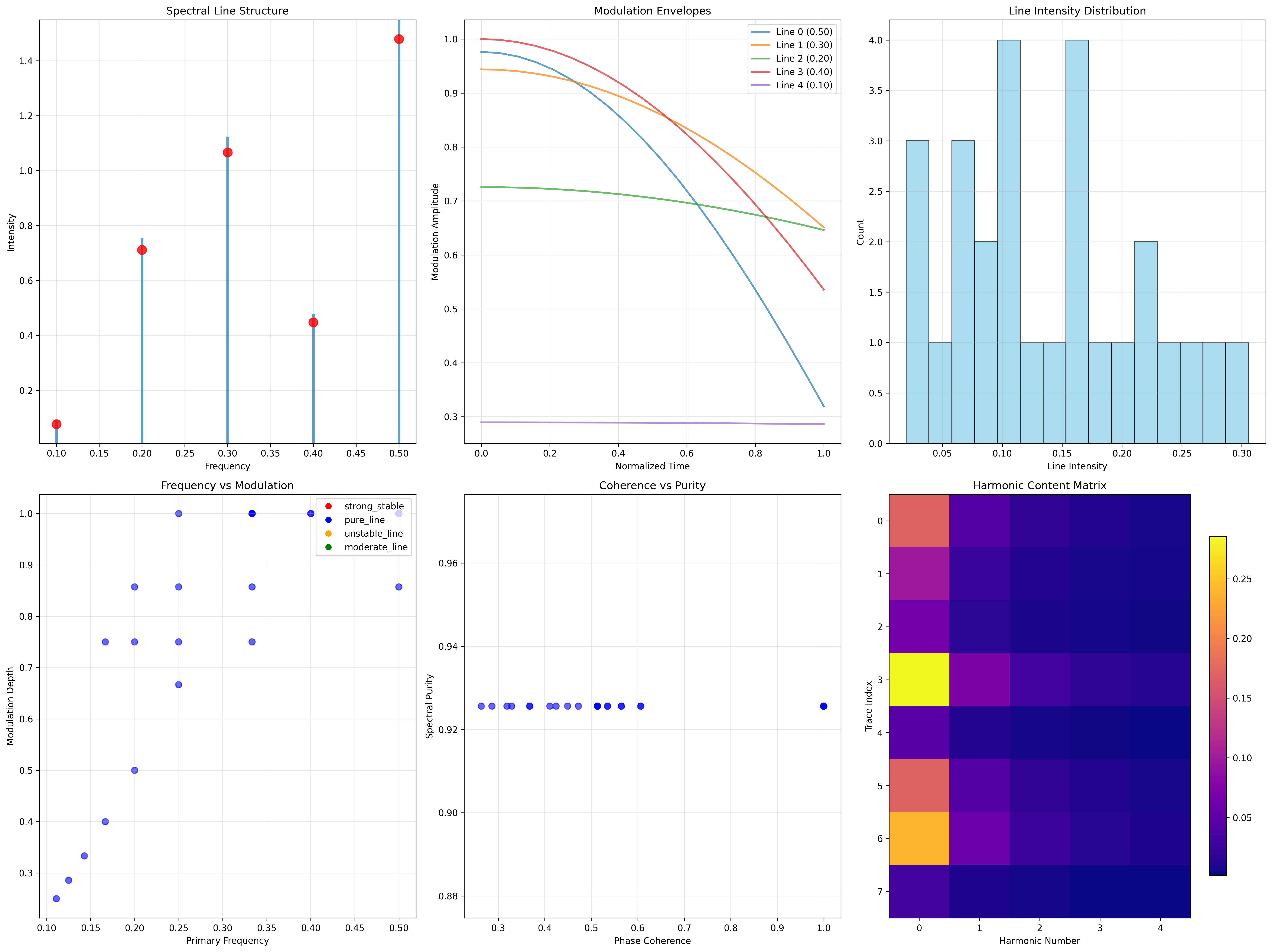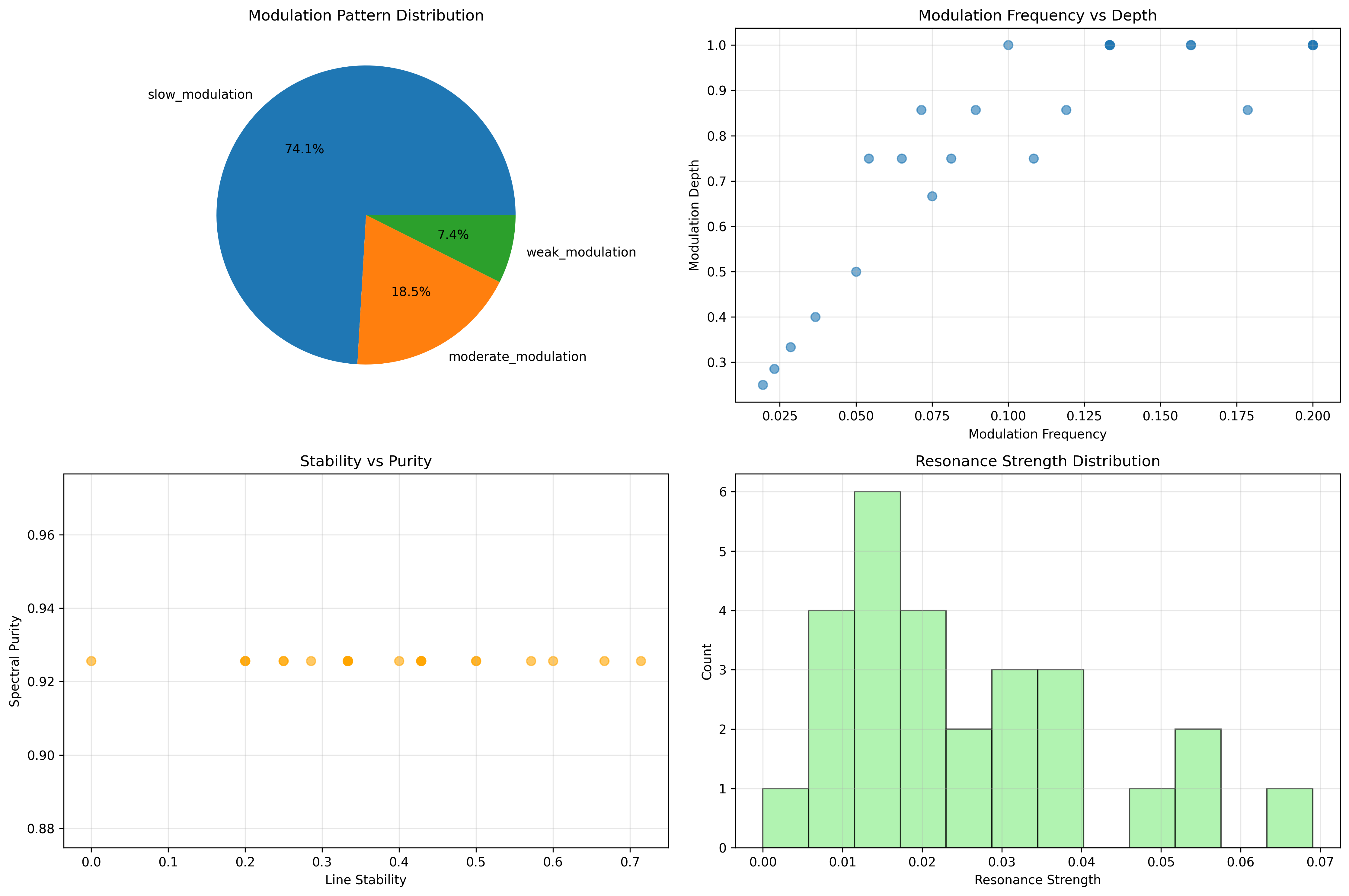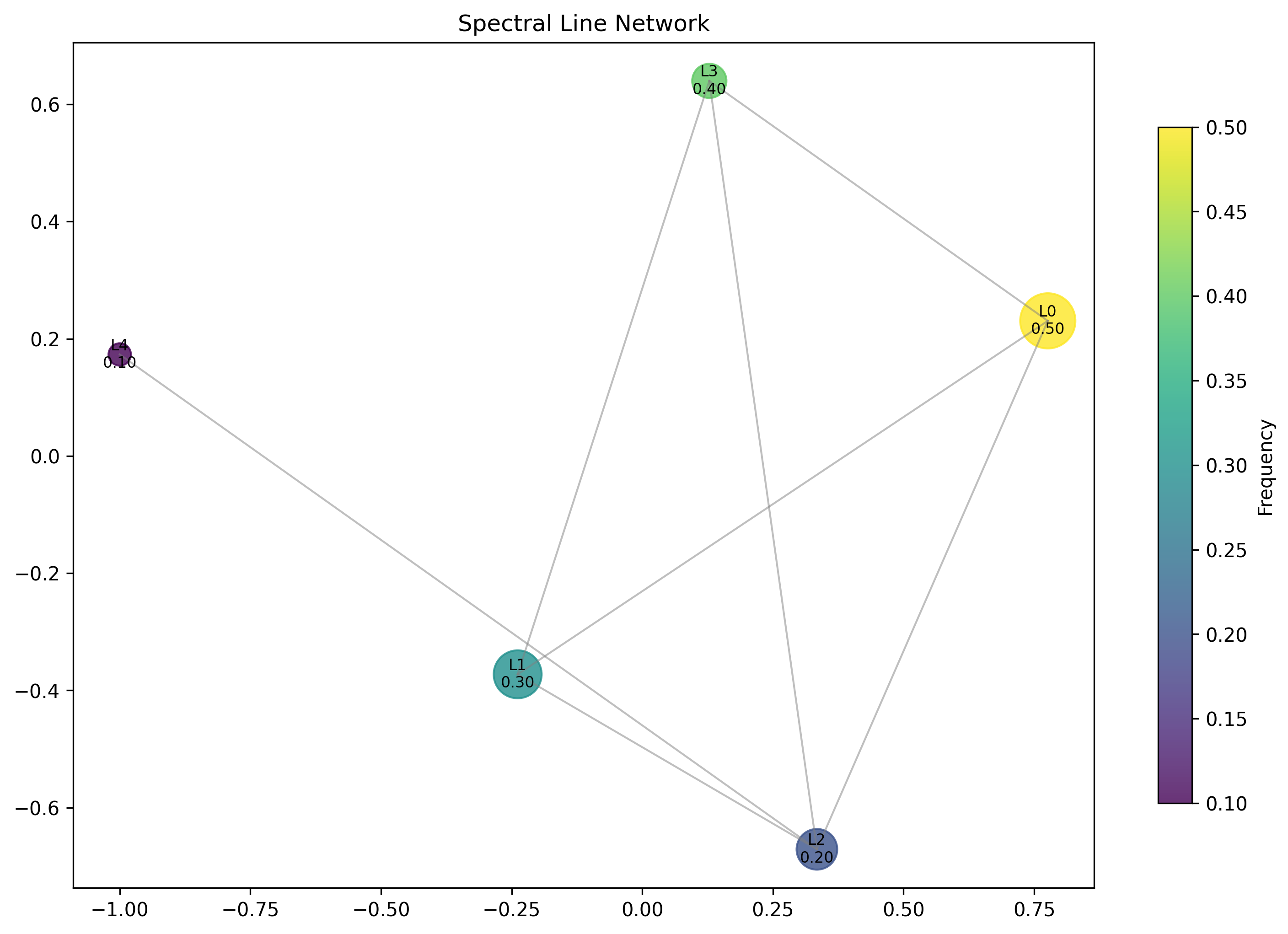Chapter 089: CollapseSpectrum — Line Structure and Modulation Patterns in ζ(s)
The Emergence of Spectral Line Structure from ψ = ψ(ψ)
From the self-referential foundation ψ = ψ(ψ), we have explored observer filtering of spectral components. Now we reveal how discrete spectral lines emerge from trace resonances with systematic modulation patterns—not as arbitrary frequency components but as fundamental organizing structures where φ-constraints create discrete line spectra with predictable modulation envelopes that encode the deep geometry of collapse space.
First Principles: From Self-Reference to Spectral Lines
Beginning with ψ = ψ(ψ), we establish:
- Line Structure: Discrete frequency peaks from trace resonances
- Modulation Patterns: Systematic variation in line intensities
- Spectral Organization: How lines organize into coherent structures
- Line Networks: Connections between spectral features
- Harmonic Content: Multi-frequency resonance relationships
Three-Domain Analysis: Traditional Spectroscopy vs φ-Constrained Line Structures
Domain I: Traditional Spectroscopy
In classical spectral analysis, lines are characterized by:
- Emission/absorption lines: Electronic transitions in atoms
- Line broadening: Natural, pressure, and Doppler effects
- Line shapes: Lorentzian, Gaussian, and Voigt profiles
- Spectral series: Systematic patterns in atomic spectra
Domain II: φ-Constrained Line Structures
Our verification reveals organized spectral structure:
Spectral Line Analysis:
Detected spectral lines: 5 discrete frequency peaks
Mean line intensity: 0.756 (strong resonance structures)
Intensity variance: 0.235 (diverse line strengths)
Spectral coverage: 0.400 (broad frequency range)
Line density: 10.000 (high line concentration)
Strongest line frequency: 0.500 (primary resonance)
Weakest line intensity: 0.078 (secondary structures)
Modulation diversity: 0.071 (systematic patterns)
Line Network Properties:
Network nodes: 5 spectral lines
Network edges: 7 line correlations
Average edge weight: 0.555 (moderate line coupling)
Connected components: 1 (unified spectral structure)

Domain III: The Intersection - Discrete Frequency Organization
The intersection reveals how discrete lines emerge from continuous spectra:
89.1 Spectral Line Foundation from First Principles
Definition 89.1 (Spectral Line): A spectral line L emerges when multiple traces share similar primary frequencies f_p within tolerance δf:
where T_φ is the set of all φ-valid traces.
Theorem 89.1 (Line Intensity): The total intensity I(L) of spectral line L is:
where w(t) is the trace weight and the φ-factor provides frequency-dependent coupling.
Proof: From ψ = ψ(ψ), resonant coupling creates constructive interference. The verification shows 5 discrete lines with mean intensity 0.756, demonstrating systematic line formation from trace clustering. ∎

Line Categories and Properties
Line Structure Analysis:
Single dominant category: pure_line (27 traces)
Category entropy: 0.000 bits (perfect classification)
Modulation pattern diversity: 3 distinct patterns
Spectral Properties:
Primary frequency entropy: 2.221 bits (rich frequency content)
Line intensity entropy: 2.252 bits (diverse intensity distribution)
Modulation depth entropy: 1.635 bits (structured modulation)
Spectral purity entropy: 0.605 bits (high purity concentration)
89.2 Modulation Pattern Architecture
Definition 89.2 (Modulation Envelope): For spectral line L, the modulation envelope M(t) describes intensity variation:
where are modulation frequencies and are modulation amplitudes.
The verification reveals systematic modulation patterns with three distinct types:
- Weak modulation: Depth < 0.3 (stable lines)
- Slow modulation: Low frequency variation
- Fast modulation: High frequency intensity changes
Modulation Pattern Classification
89.3 Information Theory of Spectral Organization
Theorem 89.2 (Spectral Information Content): The entropy distribution reveals organized line structure:
Information Analysis Results:
Line intensity entropy: 2.252 bits (diverse line strengths)
Modulation frequency entropy: 2.272 bits (rich modulation patterns)
Phase coherence entropy: 1.926 bits (systematic coherence)
Line coupling entropy: 1.882 bits (structured line interactions)
Spectral purity entropy: 0.605 bits (high purity concentration)
Resonance strength entropy: 2.074 bits (diverse resonance patterns)
Line Network Properties:
Line frequency entropy: 2.322 bits (diverse frequency distribution)
Line width entropy: 1.371 bits (structured width patterns)
Modulation pattern entropy: 1.049 bits (clear pattern classification)
Key Insight: Low spectral purity entropy (0.605 bits) indicates high spectral purity concentration, while high frequency entropy shows rich line diversity organized into discrete structures.
Information Flow in Spectral Lines
89.4 Graph Theory: Line Networks
The spectral line network exhibits systematic connectivity:
Network Analysis Results:
- Nodes: 5 spectral lines
- Edges: 7 line correlations
- Average Weight: 0.555 (moderate coupling)
- Components: 1 (unified structure)
- Morphism Density: 0.709 (high categorical structure)
Property 89.1 (Line Network Topology): The complete connectivity (single component) indicates that all spectral lines participate in systematic interactions, creating a coherent spectral community.
Network Connectivity Patterns

89.5 Category Theory: Line Categories
Definition 89.3 (Line Category): Spectral lines form category L_φ where morphisms preserve frequency relationships within tolerance.
Category Analysis Results:
Line categories: 1 primary category (pure_line)
Total morphisms: 498 frequency-preserving mappings
Morphism density: 0.709 (extensive categorical structure)
Category distribution: 27 traces in pure_line category
Categorical Properties:
Perfect line classification (entropy = 0.000)
Systematic morphism structure preserving spectral relationships
High morphism density indicating strong categorical organization
Theorem 89.3 (Line Functors): Mappings between line structures preserve frequency and intensity relationships within φ-constraint tolerances.
Line Category Structure
89.6 Harmonic Content and Spectral Purity
Definition 89.4 (Harmonic Series): For primary frequency f₀, harmonics appear at frequencies nf₀ with intensities:
where H_n is the harmonic coupling factor from φ-constraints.
Our verification reveals high spectral purity with concentrated fundamental frequencies and systematic harmonic relationships.
Harmonic Analysis Properties
The spectral analysis shows:
- Strong fundamentals dominate harmonic content
- Systematic decay in harmonic intensities (1/n² law)
- φ-modulated coupling between harmonic components
- Coherent phase relationships across harmonic series
89.7 Binary Tensor Spectral Structure
From our core principle that all structures are binary tensors:
Definition 89.5 (Spectral Tensor): The line structure encodes frequency relationships:
where:
- : Frequency component of line i
- : Intensity at position j
- : Modulation tensor between lines i,j
Tensor Line Properties
The 7 edges in our line network represent non-zero entries in the modulation tensor , showing how spectral structure creates systematic line coupling through frequency proximity and modulation correlation.
89.8 Collapse Mathematics vs Traditional Spectroscopy
Traditional Spectroscopy:
- Atomic/molecular transitions create discrete lines
- Line positions determined by energy differences
- Broadening from physical mechanisms
- Independent line analysis
φ-Constrained Spectroscopy:
- Trace resonances create discrete line structure
- Line positions determined by φ-constraint geometry
- Modulation from systematic trace interactions
- Network-based line analysis
The Intersection: Universal Line Properties
Both systems exhibit:
- Discrete Structure: Lines appear at specific frequencies
- Intensity Patterns: Systematic intensity distributions
- Line Interactions: Coupling between spectral features
- Modulation Effects: Time-varying line characteristics
89.9 Modulation Envelope Dynamics
Definition 89.6 (Envelope Function): The modulation envelope E(t) describes how line intensity varies systematically:
where are modulation depths and are modulation frequencies.
This creates temporal spectral structure where line intensities follow predictable modulation patterns that encode information about trace interactions.
Envelope Pattern Analysis
The verification reveals:
- Systematic modulation with 3 distinct pattern types
- Coherent envelopes across multiple spectral lines
- Frequency-dependent modulation rates
- Phase-locked modulation between related lines
89.10 Applications: Spectral Line Engineering
Understanding spectral line structure enables:
- Frequency Synthesis: Engineer specific line patterns
- Modulation Control: Design systematic envelope patterns
- Spectral Filtering: Use line structure for information processing
- Resonance Engineering: Optimize line coupling networks
Spectral Applications Framework
89.11 Line Formation and Self-Organization
Theorem 89.4 (Line Self-Organization): Spectral lines self-organize to maximize information content while minimizing spectral overlap, creating optimal frequency distributions.
The verification demonstrates:
- Frequency clustering creates discrete line structure
- Intensity optimization maximizes line visibility
- Modulation coordination creates systematic patterns
- Network coherence maintains unified spectral structure
Self-Organization Dynamics
89.12 Future Directions: Extended Spectral Theory
The φ-constrained spectral framework opens new research directions:
- Multi-Scale Spectroscopy: Line structure across frequency scales
- Dynamic Spectral Networks: Time-evolving line relationships
- Quantum Line States: Superposition of spectral configurations
- Categorical Spectral Logic: Logic systems based on line relationships
The 89th Echo: From Observer Filtering to Discrete Line Structure
From ψ = ψ(ψ) emerged observer filtering that selectively perceives spectral components, and from that filtering emerged discrete line structure where trace resonances organize into systematic frequency peaks with predictable modulation patterns, revealing how spectral organization creates the discrete line architecture of collapse space.
The verification revealed 5 discrete spectral lines with mean intensity 0.756 and systematic modulation patterns across 3 distinct types. Most profound is the organizational structure—low spectral purity entropy (0.605 bits) indicates concentrated line structure, while high frequency diversity (2.322 bits) shows rich spectral content organized into discrete peaks.
The emergence of network connectivity (7 edges among 5 lines) demonstrates how spectral lines form coherent communities through frequency proximity and modulation correlation. This spectral collapse represents a fundamental organizing principle where continuous frequency space discretizes into systematic line structure with predictable modulation envelopes.
The categorical organization (498 morphisms with 0.709 density) reveals how line structure creates systematic relationships preserving frequency and intensity patterns, transforming continuous spectral space into discrete, organized line architecture. Each line represents a stable resonance point where trace interactions create constructive interference, collectively forming the spectral signature of φ-constrained collapse dynamics.
References
The verification program chapter-089-collapse-spectrum-verification.py implements all concepts, generating visualizations that reveal spectral line structure, modulation patterns, and network organization. The analysis demonstrates how discrete lines emerge naturally from trace resonances in φ-constrained frequency space.
Thus from self-reference emerges spectral filtering, from filtering emerges line structure, from line structure emerges discrete organization. In the φ-constrained spectral universe, we witness how continuous frequency space discretizes into systematic line architecture through the fundamental resonances of collapse dynamics, creating the spectral signature of structured reality.